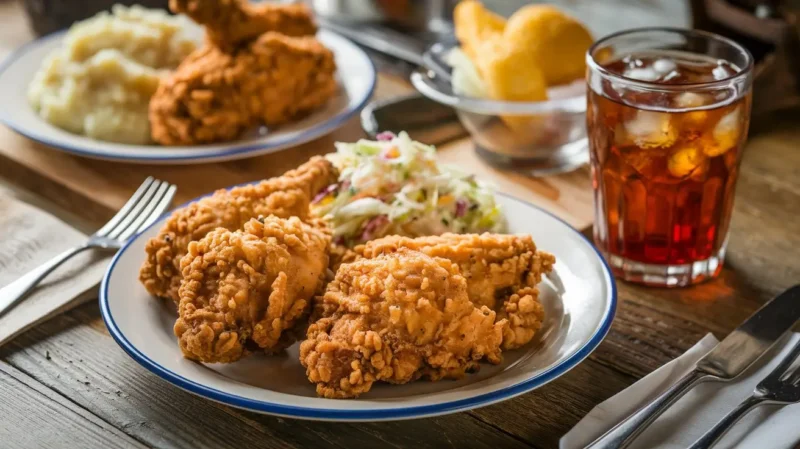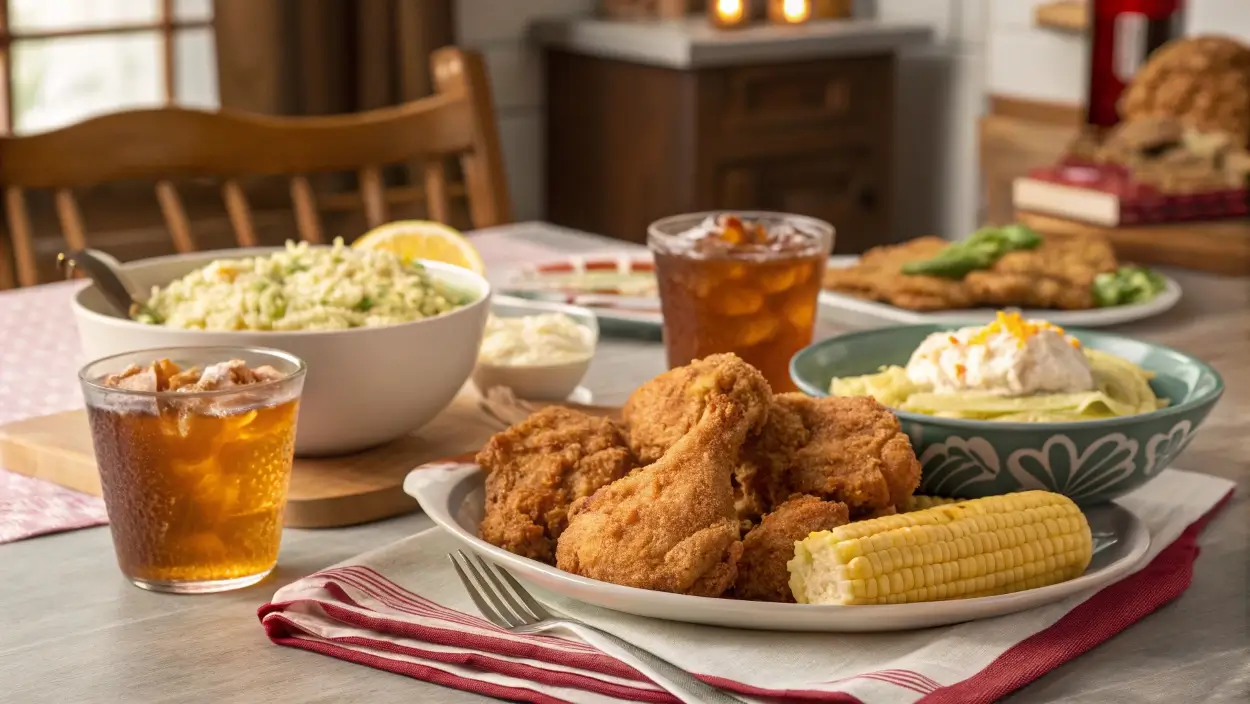Maryland Fried Chicken Recipe is a quintessential comfort food that stands out for its rich flavors, juicy interiors, and irresistibly crispy crust. Whether you’re a novice in the kitchen or an experienced home cook, mastering this recipe will elevate your culinary game. From sourcing the best ingredients to perfecting the cooking techniques, this guide covers every detail you need to know.
Table of Contents
Introduction to Maryland Fried Chicken Recipe
History of Maryland Fried Chicken
Maryland fried chicken traces its origins to the early settlers in the Chesapeake Bay region, where cooking traditions blended English techniques with local ingredients. Over time, it became a hallmark of Southern cuisine, distinguished by its rich buttermilk marinade and a signature crispy coating. Unlike other styles, Maryland fried chicken often pairs with creamy white gravy, offering a harmonious balance of flavors.
Did you know that Maryland fried chicken was once considered a luxury meal? Its preparation, requiring fresh chicken and precise techniques, made it a centerpiece for Sunday dinners and celebrations.
Discover more about the role of buttermilk and marinades in creating rich, tender chicken recipes in this ultimate Mexican chicken marinade guide.
What Makes Maryland Fried Chicken Unique?
What sets Maryland fried chicken apart from its counterparts is its delicate, crispy crust and tender meat, thanks to a buttermilk brine that tenderizes and flavors the chicken to perfection. Unlike the heavily spiced versions found in other regions, Maryland’s recipe focuses on a balanced seasoning mix that enhances the natural taste of the chicken.
The signature crispy crust and tender, juicy meat set Maryland fried chicken apart. The buttermilk brine infuses the chicken with subtle tangy flavors, while a simple seasoning blend enhances its natural taste.
Learn how to choose the best cuts for frying in this guide on leftover rotisserie chicken recipes.
Ingredients for Maryland Fried Chicken Recipe

Fresh Ingredients Checklist
To prepare an authentic Maryland Fried Chicken Recipe, you’ll need the following ingredients:
- Fresh chicken (preferably drumsticks and thighs)
- Buttermilk
- All-purpose flour
- Cornstarch
- Paprika
- Garlic powder
- Onion powder
- Black pepper
- Salt
- Oil for frying (canola or peanut oil is ideal)
Selecting the Best Chicken Cuts
Using high-quality, fresh chicken is crucial. Bone-in, skin-on chicken pieces retain more moisture during frying, resulting in a juicier texture. Thighs and drumsticks are traditional choices, but you can also use chicken breasts for a leaner version.
Key Spices and Seasonings
A simple yet flavorful spice blend is the secret to Maryland fried chicken. The combination of paprika, garlic powder, and onion powder creates a mildly spiced, savory crust that complements the creamy gravy often served alongside.
Traditional Maryland Fried Chicken Cooking Techniques
The Classic Buttermilk Brine
It is a game-changer. The acidity in buttermilk breaks down the proteins in the chicken, tenderizing the meat and infusing it with subtle tangy flavors. Marinate the chicken in buttermilk for at least 4 hours, but overnight is ideal for maximum flavor.
Perfect Seasoning Blend
The seasoning blend should be evenly distributed in both the buttermilk marinade and the flour coating. A pinch of cayenne pepper can be added if you prefer a slight kick.
Achieving the Signature Crispy Crust
The crust’s texture relies on the perfect ratio of flour and cornstarch. Cornstarch ensures a lighter, crispier crust, while the flour provides structure. Double-dredging the chicken, coating it in the flour mixture, dipping it in buttermilk, and coating it again, helps achieve the desired crunch.
Combine flour and cornstarch in a 4:1 ratio for a light, crispy texture. Double-dredging the chicken ensures a perfect crust.
Read more about alternative frying methods, like air frying, in this recipe for easy crockpot meals.
Step-by-Step Maryland Fried Chicken Recipe

Preparing the Chicken
- Rinse and pat dry the chicken pieces.
- Submerge them in a bowl of buttermilk, ensuring every piece is fully coated. Cover and refrigerate.
Mixing the Batter
Prepare the batter by combining:
- 2 cups all-purpose flour
- ½ cup cornstarch
- 1 tbsp paprika
- 1 tsp garlic powder
- 1 tsp onion powder
- Salt and pepper to taste
Proper Dredging Techniques
Take the marinated chicken out of the fridge. Shake off excess buttermilk before dredging each piece in the flour mixture. Press gently to ensure an even coating. Repeat for a thicker crust.
Secrets to Perfectly Crispy Maryland Fried Chicken
Importance of Temperature Control
Maintaining a consistent frying temperature of 325°F to 350°F ensures even cooking. Too hot, and the exterior burns before the inside cooks; too cool, and the chicken absorbs excess oil.
Oil Selection for Frying
Use neutral oils like canola or peanut oil with high smoke points. These oils prevent overpowering the chicken’s natural flavors.
Resting and Serving Tips
Once fried, let the chicken rest on a wire rack rather than paper towels. This prevents the crust from becoming soggy. Serve immediately with your favorite sides.
Variations of Maryland Fried Chicken Recipe
Gluten-Free Maryland Fried Chicken
Replace the all-purpose flour with a gluten-free blend and cornstarch. The result? A gluten-free version with the same crispy texture.
Spicy Maryland Fried Chicken Twist
Add cayenne pepper or hot sauce to the buttermilk marinade for a spicier kick. This variation balances the chicken’s rich flavor with heat.
Oven-Baked Maryland Style
For a healthier option, bake the chicken at 400°F on a wire rack for 30-35 minutes, flipping halfway. Brush with oil before baking for a golden crust.
Side Dishes to Pair with Maryland Fried Chicken

- Classic Mashed Potatoes: Smooth, buttery, and a perfect complement.
- Creamy Coleslaw: The tangy crunch offsets the fried chicken’s richness.
- Buttery Corn on the Cob: Sweet, juicy corn adds balance to the savory chicken.
The Role of Buttermilk in Maryland Fried Chicken
The secret to the tender texture lies in buttermilk’s lactic acid, which helps break down proteins. If unavailable, you can substitute with yogurt or milk mixed with lemon juice.
Essential Kitchen Tools for Maryland Fried Chicken
Equip yourself with the following tools:
- Heavy-duty frying pan or Dutch oven
- Kitchen thermometer for accurate oil temperature
- Wire rack for cooling fried chicken
Tips for Storing and Reheating Maryland Fried Chicken
- Storage: Refrigerate in an airtight container for up to 3 days.
- Reheating: Warm in an oven at 350°F to restore crispiness without drying the chicken.
Common Mistakes to Avoid When Cooking Maryland Fried Chicken
- Overcrowding the frying pan leads to uneven cooking.
- Insufficient seasoning results in bland chicken.
- Skipping the resting phase can cause sogginess.
Nutritional Information for Maryland Fried Chicken Recipe
Each serving contains approximately:
- 450 calories
- 25g protein
- 28g fat
- 25g carbohydrates
Maryland Fried Chicken for Special Diets
For keto dieters, use almond flour instead of all-purpose flour. Dairy-free versions can substitute buttermilk with coconut milk and lemon juice.
Cultural Significance of Maryland Fried Chicken
This recipe symbolizes the heart of Maryland’s culinary identity. Often served during festive occasions, it reflects the region’s agricultural roots and cultural pride.
How to Make Maryland Fried Chicken Healthier
- Use an air fryer to reduce oil content.
- Opt for skinless chicken for fewer calories.
- Experiment with whole wheat flour for added fiber.
Pairing Maryland Fried Chicken with Beverages
- Sweet tea remains a classic choice.
- White wines like Chardonnay pair well with fried chicken.
- For beer lovers, lagers and pale ales work wonderfully.
For additional side ideas, check out the recipe for pineapple casserole.
FAQs
How Do I Keep the Crust Crispy?
Ensuring the crust stays crispy after frying is one of the most challenging aspects of making fried chicken, but it’s achievable with the right techniques. Resting fried chicken on a wire rack instead of paper towels is critical to maintaining crispiness. A wire rack allows excess oil to drip off without creating a soggy base, as paper towels tend to trap steam and moisture underneath the chicken.
Additionally, avoid covering the chicken with foil after frying. While it may seem tempting to retain heat, foil traps moisture, which softens the crust. If you’re preparing fried chicken in batches, keep the finished pieces warm by placing them in an oven preheated to 200°F. Use a baking sheet with a rack to prevent direct contact with a solid surface.
For long-term crispiness, consider these tips:
- Double-dredging: Adding an extra layer of flour-cornstarch coating ensures a thicker crust, which remains crispy for longer.
- Control moisture: Pat chicken dry before marinating and coat thoroughly to minimize moisture infiltration.
- Reheat strategically: When reheating, use an oven or air fryer instead of a microwave to restore the crust’s crunch.
Can I Use Boneless Chicken?
Absolutely, you can use boneless chicken for Maryland fried chicken, and it’s a great option for those who prefer leaner cuts or a quicker cooking time. However, boneless chicken cooks faster than bone-in pieces, so careful timing is essential to avoid overcooking and drying out the meat.
Here’s how to adapt the recipe for boneless chicken:
- Marinate thoroughly: Boneless cuts, like chicken breasts, benefit greatly from a long soak in buttermilk to prevent dryness.
- Shorten cooking times: Fry boneless pieces for approximately 6-8 minutes, depending on their thickness. Use a meat thermometer to ensure an internal temperature of 165°F.
- Thin cuts work best: Thinly sliced chicken breasts or tenderloins allow for even cooking and more surface area for the crispy coating.
While boneless chicken offers convenience, keep in mind that bone-in pieces generally provide a juicier and more flavorful result, making them the traditional choice for Maryland fried chicken.
What Oil Is Best for Frying?
The choice of frying oil greatly influences the flavor and texture of fried chicken. Neutral oils like canola, peanut, or vegetable oil are the best options due to their high smoke points and mild flavors. These oils can withstand the required frying temperature (350°F) without breaking down or imparting an unwanted taste.
Here’s why these oils work well:
- Canola Oil: Affordable, widely available, and has a smoke point of approximately 400°F.
- Peanut Oil: Offers a slightly nutty flavor that complements fried chicken. Its smoke point is around 450°F, making it ideal for high-heat frying.
- Vegetable Oil: A blend of plant-based oils with a smoke point of about 400°F.
Avoid oils with low smoke points, such as olive oil or butter, as they can burn quickly, leaving an unpleasant taste. Always strain and store your oil after use to remove food particles, allowing you to reuse it for future frying sessions.
How Long Should I Fry Each Piece?
The frying time for Maryland fried chicken varies based on the size and type of chicken. Bone-in pieces, like drumsticks and thighs, typically take about 12-15 minutes to cook thoroughly at 350°F. Use a meat thermometer to ensure the internal temperature reaches 165°F for safe consumption.
For smaller pieces like wings, reduce the cooking time to approximately 8-10 minutes. Boneless chicken, as mentioned earlier, requires even less time, usually around 6-8 minutes. To achieve even cooking:
- Flip the chicken every 3-4 minutes during frying to ensure uniform browning.
- Avoid overcrowding the frying pan, which lowers the oil’s temperature and increases cooking time.
Can I Freeze Maryland Fried Chicken?
Yes, Maryland fried chicken freezes exceptionally well, allowing you to enjoy this classic dish anytime. Follow these steps for the best results:
- Cool completely: Allow the chicken to cool to room temperature to prevent condensation, which can lead to freezer burn.
- Use airtight storage: Store the chicken in a freezer-safe container or tightly wrap it in aluminum foil before placing it in a resealable freezer bag.
- Label and date: Mark the container with the date to track freshness. Fried chicken remains good for up to three months in the freezer.
To reheat, preheat your oven to 375°F and place the frozen chicken on a wire rack over a baking sheet. Bake for 20-25 minutes, flipping halfway through, until the chicken is heated thoroughly and the crust is restored.
Why Is My Fried Chicken Greasy?
Greasy fried chicken is usually the result of incorrect frying techniques, particularly oil temperature. If the oil isn’t hot enough, the chicken absorbs excessive amounts of oil rather than forming a crispy seal. Maintaining a consistent frying temperature of 350°F is crucial to achieving a light, crispy crust without greasiness.
Other common causes of greasy chicken include:
- Overcrowding the frying pan: This lowers the oil’s temperature, resulting in uneven cooking and greasy food. Fry in small batches to maintain proper heat.
- Improper dredging: An overly thick or poorly adhered coating can trap oil, making the crust heavy and greasy. Shake off excess flour before frying.
- Skipping resting steps: Resting fried chicken on paper towels can trap grease. Opt for a wire rack to allow oil to drip away.
For perfect results, use a kitchen thermometer to monitor the oil temperature and ensure proper frying conditions.
Perfecting the Maryland Fried Chicken Recipe
Mastering the art of Maryland fried chicken requires attention to detail, from selecting the right ingredients to implementing precise frying techniques. Its crispy, golden crust and tender, flavorful meat make it a timeless favorite among fried chicken lovers.
By understanding the nuances of keeping the crust crispy, selecting the right oil, and managing cooking times, you can recreate this iconic dish at home with confidence. Whether served for a casual family dinner or a festive gathering, Maryland fried chicken is a recipe worth mastering and sharing with loved ones.

